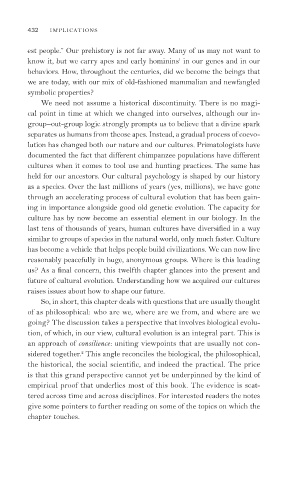Page 467 - Cultures and Organizations
P. 467
432 IMPLICATIONS
est people.” Our prehistory is not far away. Many of us may not want to
1
know it, but we carry apes and early hominins in our genes and in our
behaviors. How, throughout the centuries, did we become the beings that
we are today, with our mix of old-fashioned mammalian and newfangled
symbolic properties?
We need not assume a historical discontinuity. There is no magi-
cal point in time at which we changed into ourselves, although our in-
group–out-group logic strongly prompts us to believe that a divine spark
separates us humans from theose apes. Instead, a gradual process of coevo-
lution has changed both our nature and our cultures. Primatologists have
documented the fact that different chimpanzee populations have different
cultures when it comes to tool use and hunting practices. The same has
held for our ancestors. Our cultural psychology is shaped by our history
as a species. Over the last millions of years (yes, millions), we have gone
through an accelerating process of cultural evolution that has been gain-
ing in importance alongside good old genetic evolution. The capacity for
culture has by now become an essential element in our biology. In the
last tens of thousands of years, human cultures have diversified in a way
similar to groups of species in the natural world, only much faster. Culture
has become a vehicle that helps people build civilizations. We can now live
reasonably peacefully in huge, anonymous groups. Where is this leading
us? As a final concern, this twelfth chapter glances into the present and
future of cultural evolution. Understanding how we acquired our cultures
raises issues about how to shape our future.
So, in short, this chapter deals with questions that are usually thought
of as philosophical: who are we, where are we from, and where are we
going? The discussion takes a perspective that involves biological evolu-
tion, of which, in our view, cultural evolution is an integral part. This is
an approach of consilience: uniting viewpoints that are usually not con-
2
sidered together. This angle reconciles the biological, the philosophical,
the historical, the social scientific, and indeed the practical. The price
is that this grand perspective cannot yet be underpinned by the kind of
empirical proof that underlies most of this book. The evidence is scat-
tered across time and across disciplines. For interested readers the notes
give some pointers to further reading on some of the topics on which the
chapter touches.

